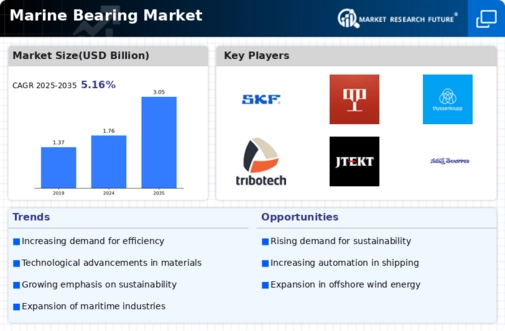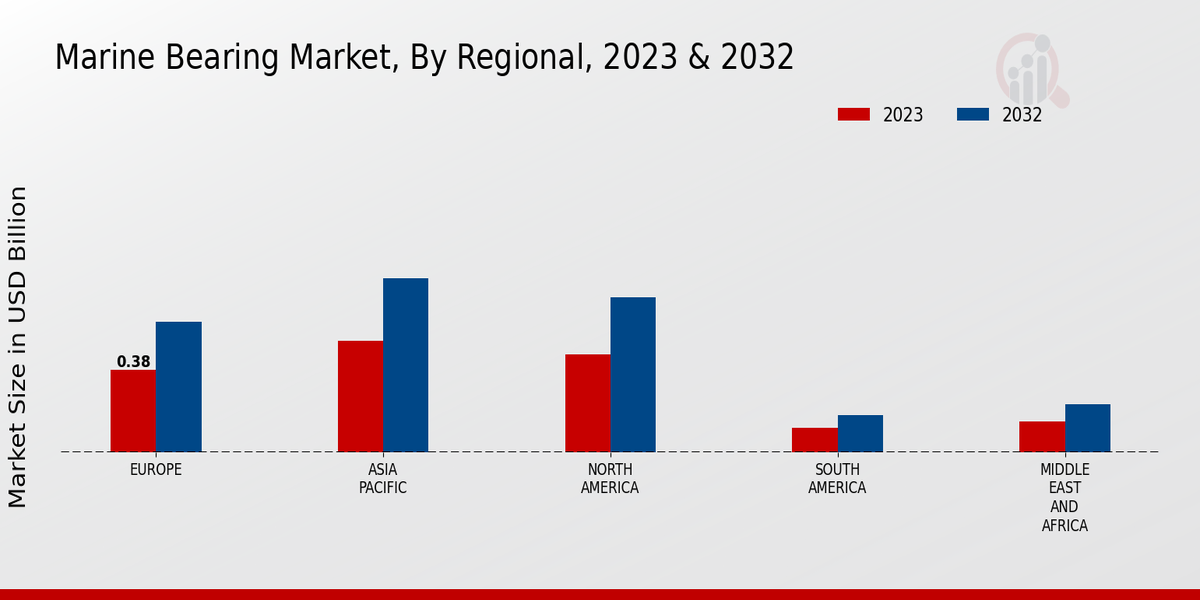Market Growth Projections
The Global Marine Bearing Market Industry is poised for substantial growth, with projections indicating an increase from 1.76 USD Billion in 2024 to 3.05 USD Billion by 2035. This growth trajectory suggests a compound annual growth rate (CAGR) of 5.12% from 2025 to 2035. Such projections reflect the industry's response to various drivers, including technological advancements, regulatory changes, and increasing demand for marine transportation. The anticipated growth underscores the market's resilience and adaptability in a rapidly evolving global landscape, positioning it as a critical component of the broader maritime industry.
Expansion of Shipbuilding Activities
The expansion of shipbuilding activities globally serves as a significant driver for the Global Marine Bearing Market Industry. As countries invest in their maritime capabilities, the demand for new vessels increases, subsequently driving the need for high-performance marine bearings. Shipbuilders are increasingly focusing on quality and reliability, which in turn boosts the demand for advanced bearing solutions. This trend is expected to sustain the market's growth, with projections indicating a rise from 1.76 USD Billion in 2024 to 3.05 USD Billion by 2035. The shipbuilding industry's expansion is likely to create a favorable environment for marine bearing manufacturers.
Growth of the Renewable Energy Sector
The growth of the renewable energy sector, particularly offshore wind energy, presents a compelling opportunity for the Global Marine Bearing Market Industry. As the world shifts towards sustainable energy sources, the demand for marine bearings in wind turbine applications is expected to rise. Bearings used in these applications must withstand harsh marine environments, thus requiring advanced engineering and materials. This trend is likely to contribute to the market's expansion, as investments in renewable energy infrastructure increase. The anticipated growth trajectory, from 1.76 USD Billion in 2024 to 3.05 USD Billion by 2035, indicates a robust future for marine bearings in this sector.
Increasing Demand for Marine Transportation
The Global Marine Bearing Market Industry experiences a notable surge in demand for marine transportation, driven by the expansion of global trade and the need for efficient logistics. As economies grow, the reliance on maritime shipping increases, necessitating the use of high-quality marine bearings to ensure vessel reliability and performance. In 2024, the market is valued at 1.76 USD Billion, reflecting the industry's response to this growing demand. The need for durable and efficient bearings is paramount, as they play a critical role in reducing friction and wear in marine applications, ultimately enhancing operational efficiency.
Technological Advancements in Bearing Materials
Technological advancements in materials science significantly influence the Global Marine Bearing Market Industry. Innovations in composite materials and coatings enhance the performance and longevity of marine bearings, making them more resistant to corrosion and wear. These advancements are crucial as they align with the industry's shift towards sustainability and efficiency. As a result, manufacturers are increasingly adopting these new materials to meet the evolving demands of the marine sector. The anticipated growth from 1.76 USD Billion in 2024 to 3.05 USD Billion by 2035, with a CAGR of 5.12% from 2025 to 2035, underscores the importance of these technological developments.
Regulatory Compliance and Environmental Standards
The Global Marine Bearing Market Industry is significantly impacted by stringent regulatory compliance and environmental standards. Governments worldwide are implementing regulations aimed at reducing emissions and enhancing the sustainability of marine operations. This regulatory landscape compels manufacturers to innovate and produce bearings that meet these new standards. As a result, there is a growing demand for eco-friendly bearing solutions that minimize environmental impact. The industry's adaptation to these regulations not only ensures compliance but also positions it favorably in a market increasingly focused on sustainability, potentially driving further growth in the coming years.











